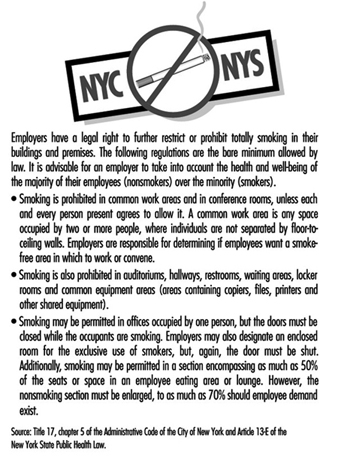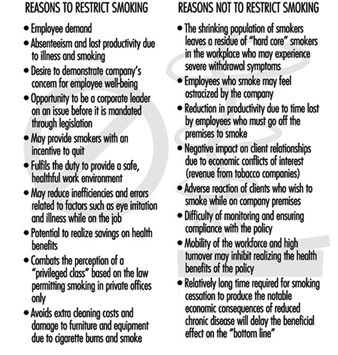In 1990, the US Government demonstrated strong support for workplace health promotion programs with the publication of Healthy People 2000, setting forth the National Health Promotion and Disease Prevention Objectives for the Year 2000 (US Public Health Service 1991). One of these objectives calls for an increase in the percentage of worksites offering health promotion activities for their employees by the year 2000, “preferably as part of a comprehensive employee health promotion program” (Objective 8.6). Two objectives specifically include efforts to prohibit or severely restrict smoking at work by increasing the percentage of worksites with a formal smoking policy (Objective 3.11) and by enacting comprehensive state laws on clean indoor air (Objective 3.12).
In response to these objectives and employee interest, Merrill Lynch and Company, Inc. (hereafter called Merrill Lynch) launched the Wellness and You program for employees at headquarters locations in New York City and in the state of New Jersey. Merrill Lynch is a US-based, global financial management and advisory company, with a leadership position in businesses serving individuals as well as corporate and institutional clients. Merrill Lynch’s 42,000 employees in more than 30 countries provide services including securities underwriting, trading and brokering; investment banking; trading of foreign exchange, commodities and derivatives; banking and lending; and insurance sales and underwriting services. The employee population is diverse in terms of ethnicity, nationality, educational achievement and salary level. Nearly half of the employee population is headquartered in the New York City metropolitan area (includes part of New Jersey) and in two service centers in Florida and Colorado.
Merrill Lynch’s Wellness and You Program
The Wellness and You program is based in the Health Care Services Department and is managed by a doctorate-level health educator who reports to the medical director. The core wellness staff consists of the manager and a full-time assistant, and is supplemented by staff physicians, nurses and employee assistance counselors as well as outside consultants as needed.
In 1993, its initial year, over 9,000 employees representing approximately 25% of the workforce participated in a variety of Wellness and You activities, including the following:
- self-help and written information programmes, including the distribution of pamphlets on a diversity of health topics and a Merrill Lynch personal health guide designed to encourage employees to get the tests, immunizations, and guidance they need to stay healthy
- educational seminars and workshops on topics of broad interest such as smoking cessation, stress management, AIDS, and Lyme disease
- comprehensive screening programmes to identify employees at risk for cardiovascular disease, skin cancer, and breast cancer. These programmes were provided by outside contractors on company premises either in health services clinics or mobile van units
- ongoing programmes, including aerobic exercise in the company cafeteria and personal weight management classes in company conference rooms
- clinical care, including influenza immunizations, dermatology services, periodic health examinations and nutritional counselling in the employee health services clinics.
In 1994, the program expanded to include an onsite gynecology screening program comprising of Pap smears and pelvic and breast examinations; and a worldwide emergency medical assistance program to help American employees locate an English-speaking doctor anywhere in the world. In 1995, wellness programs will be extended to service offices in Florida and Colorado and will reach approximately half of the entire workforce. Most services are offered to employees free of charge or at nominal cost.
Smoking Control Programs at Merrill Lynch
Anti-smoking programs have gained a prominent place in the workplace wellness arena in recent years. In 1964, the US Surgeon General identified smoking as the single cause of the greater part of preventable disease and premature death (US Department of Health, Education, and Welfare 1964). Since then, research has demonstrated that the health risk from inhaling tobacco smoke is not limited to the smoker, but includes those who inhale second-hand smoke (US Department of Health and Human Services 1991). Consequently, many employers are taking steps to limit or curtail smoking by employees out of concern for employee health as well as their own “bottom lines”. At Merrill Lynch, Wellness and You includes three types of smoking cessation effort: (1) the distribution of written material, (2) smoking cessation programs, and (3) restrictive smoking policies.
Written materials
The wellness program maintains a wide selection of quality educational materials to provide information, assistance and encouragement to employees to improve their health. Self-help materials such as pamphlets and audiotapes designed to educate employees about the harmful effects of smoking and about the benefits of quitting are available in the health care clinic waiting rooms and through interoffice mail by request.
Written materials also are distributed at health fairs. Often these health fairs are sponsored in conjunction with national health initiatives so as to capitalize on existing media attention. For example, on the third Thursday of each November, the American Cancer Society sponsors the Great American Smokeout. This national campaign, designed to encourage smokers to give up cigarettes for 24 hours, is well publicized throughout the United States by television, radio and newspapers. The idea is that if smokers can prove to themselves that they can quit for the day, they might quit for good. In 1993’s Smokeout, 20.5% of smokers in the United States (9.4 million) stopped smoking or reduced the number of cigarettes they smoked for the day; 8 million of them reported continuing not to smoke or reducing their smoking one to ten days later.
Each year, members of Merrill Lynch’s medical department set up quit-smoking booths on the day of the Great American Smokeout at home office locations. Booths are stationed in high-traffic locations (lobbies and cafeterias) and provide literature, “survival kits” (containing chewing gum, cinnamon sticks, and self-help materials), and quit-smoking pledge cards to encourage smokers to quit smoking at least for the day.
Smoking cessation programs
Since no single smoking cessation program works for everyone, employees at Merrill Lynch are offered a variety of options. These include self-help written materials (“quit kits”), group programs, audiotapes, individual counseling and physician intervention. Interventions range from education and classic behavior modification to hypnosis, nicotine replacement therapy (e.g., “the patch” and nicotine chewing gum), or a combination. Most of these services are available to employees free of charge and some programs, such as group interventions, have been subsidized by the firm’s benefits department.
Non-smoking policies
In addition to smoking cessation efforts aimed at individuals, smoking restrictions are becoming increasingly common in the workplace. Many jurisdictions in the United States, including the states of New York and New Jersey, have enacted strict workplace smoking laws that, for the most part, limit smoking to private offices. Smoking in common work areas and conference rooms is permitted, but only if each and every person present agrees to allow it. The statutes typically mandate that non-smokers’ preferences receive priority even to the point of banning smoking entirely. Figure 1 summarizes the city and state regulations applicable in New York City.
Figure 1. Summary of city and state restrictions on smoking in New York.
In many offices, Merrill Lynch has implemented smoking policies which extend beyond the legal requirements. Most headquarters cafeterias in New York City and in New Jersey have gone smoke-free. In addition, total smoking bans have been implemented in some office buildings in New Jersey and Florida, and in certain work areas in New York City.
There seems to be little debate about the adverse health effects of tobacco exposure. However, other issues should be considered in developing a corporate smoking policy. Figure 2 outlines many of the reasons why a company may or may not elect to restrict smoking beyond the legal requirements.
Figure 2. Reasons for and against restricting smoking in the workplace.
Evaluation of Smoking Cessation Programs and Policies
Given the relative youth of the Wellness and You program, no formal evaluation has yet been conducted to determine the effect of these efforts on employee morale or smoking habits. However, some studies suggest that worksite smoking restrictions are favored by a majority of employees (Stave and Jackson 1991), result in decreased cigarette consumption (Brigham et al. 1994; Baile et al. 1991; Woodruff et al. 1993), and effectively increase smoking cessation rates (Sorensen et al. 1991).


